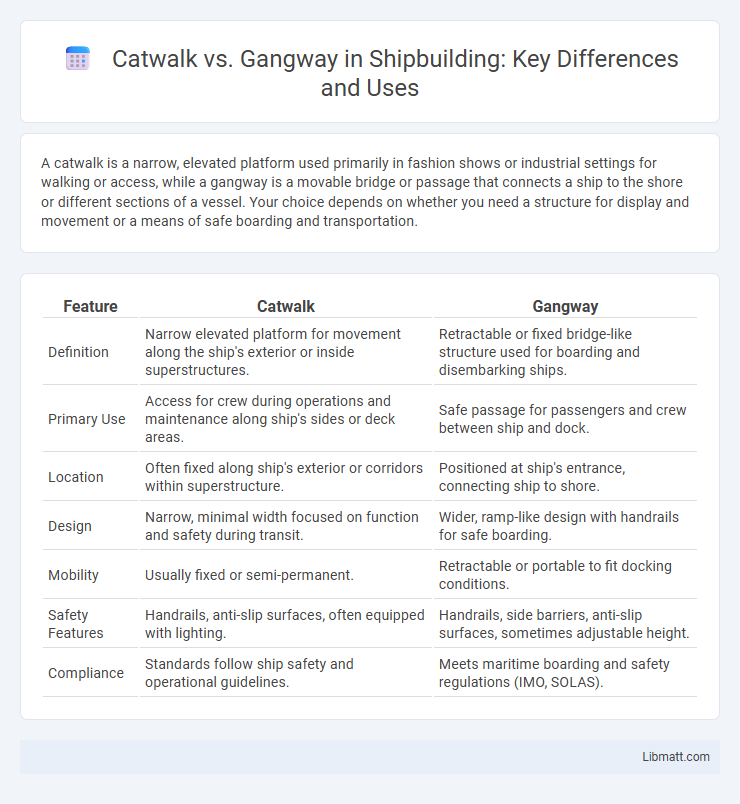A catwalk is a narrow, elevated platform used primarily in fashion shows or industrial settings for walking or access, while a gangway is a movable bridge or passage that connects a ship to the shore or different sections of a vessel. Your choice depends on whether you need a structure for display and movement or a means of safe boarding and transportation.
Table of Comparison
| Feature | Catwalk | Gangway |
|---|---|---|
| Definition | Narrow elevated platform for movement along the ship's exterior or inside superstructures. | Retractable or fixed bridge-like structure used for boarding and disembarking ships. |
| Primary Use | Access for crew during operations and maintenance along ship's sides or deck areas. | Safe passage for passengers and crew between ship and dock. |
| Location | Often fixed along ship's exterior or corridors within superstructure. | Positioned at ship's entrance, connecting ship to shore. |
| Design | Narrow, minimal width focused on function and safety during transit. | Wider, ramp-like design with handrails for safe boarding. |
| Mobility | Usually fixed or semi-permanent. | Retractable or portable to fit docking conditions. |
| Safety Features | Handrails, anti-slip surfaces, often equipped with lighting. | Handrails, side barriers, anti-slip surfaces, sometimes adjustable height. |
| Compliance | Standards follow ship safety and operational guidelines. | Meets maritime boarding and safety regulations (IMO, SOLAS). |
Introduction to Catwalks and Gangways
Catwalks and gangways serve as elevated passageways designed for safe and efficient movement in industrial, theatrical, and maritime environments. Catwalks are narrow platforms typically used in theaters and factories for accessing lighting, equipment, or machinery, while gangways function as wider, more robust walkways connecting different parts of ships or buildings. Both structures enhance operational safety by providing secure access points where ground-level traversal is impractical or hazardous.
Defining Catwalk: Key Features
A catwalk is a narrow, elevated platform primarily used in theaters, fashion shows, and industrial settings to provide safe access for personnel or showcase models. Key features include its lightweight construction, non-slip surface, and handrails for safety, designed to support foot traffic above ground level. Your choice between a catwalk and a gangway depends on load capacity, purpose, and environmental conditions.
What is a Gangway? Essential Characteristics
A gangway is a passage or walkway that provides safe and secure access between a ship and a pier or between different parts of a vessel, commonly used in maritime and industrial contexts. Its essential characteristics include portability, non-slip surfaces, handrails for safety, and adjustable lengths to accommodate various heights and docking situations. You can rely on a gangway to ensure safe boarding and disembarking, especially in environments requiring stable access over water or uneven terrain.
Structural Differences: Catwalk vs Gangway
Catwalks are narrow, elevated platforms often designed for pedestrian access in industrial, theatrical, or construction settings, featuring minimal railings and lightweight materials. Gangways serve as broader passageways, typically with sturdy railings and non-slip surfaces, facilitating safe transit between vessels or elevated areas. Structural differences emphasize catwalks' compact design for overhead accessibility versus gangways' wider, more secure construction for stable movement.
Common Applications of Catwalks
Catwalks are commonly used in theaters, warehouses, and industrial plants to provide elevated walkways for lighting, equipment access, and maintenance. These narrow platforms enable workers to safely navigate above ground level machinery or stage areas, enhancing operational efficiency. Your safety and productivity benefit from catwalks designed to support specific load capacities and secure footing in these environments.
Typical Uses of Gangways
Gangways are commonly used in maritime settings to provide safe passage between the shore and a vessel, facilitating boarding and disembarking processes. In industrial environments, gangways serve as elevated walkways that connect different sections of a facility, ensuring safe employee access over equipment or uneven terrain. These structures are also utilized in construction sites to create temporary pathways for workers to move efficiently and securely.
Safety Considerations: Catwalks vs Gangways
Catwalks typically feature safety railings and non-slip surfaces designed to prevent falls in elevated or narrow spaces, making them suitable for high-traffic industrial environments. Gangways prioritize wider walkways with guardrails and often include anti-slip coatings to facilitate safe passage between vessels or structures, especially in maritime contexts. Both structures must comply with OSHA regulations and incorporate adequate lighting, load capacity assessments, and emergency egress routes to ensure maximum safety.
Materials and Construction Methods
Catwalks are typically constructed using steel or aluminum alloys for durability and load-bearing capacity, often featuring welded joints and reinforced beams to support pedestrian traffic safely. Gangways are commonly built from lightweight materials like aluminum or composite panels, emphasizing portability and rapid assembly with bolted or riveted connections for ease of installation and flexibility. Your choice between the two depends on whether permanent structural integrity or temporary, modular convenience is prioritized in the design.
Choosing Between Catwalk and Gangway
Choosing between a catwalk and a gangway depends on your specific needs for access and safety. Catwalks provide elevated, narrow walkways ideal for maintenance or industrial environments, while gangways offer wider, accessible paths often used for boarding ships or large equipment. Your decision should consider the environment, load capacity, and the level of ease required for movement.
Conclusion: Making the Right Selection
Choosing between a catwalk and a gangway depends on your specific project needs, spatial constraints, and safety requirements. Catwalks are ideal for permanent, narrow elevated pathways, while gangways offer flexible, temporary access with greater width for heavy foot traffic. Understanding these distinctions ensures that your selection maximizes functionality and safety on site.
Catwalk vs gangway Infographic

 libmatt.com
libmatt.com